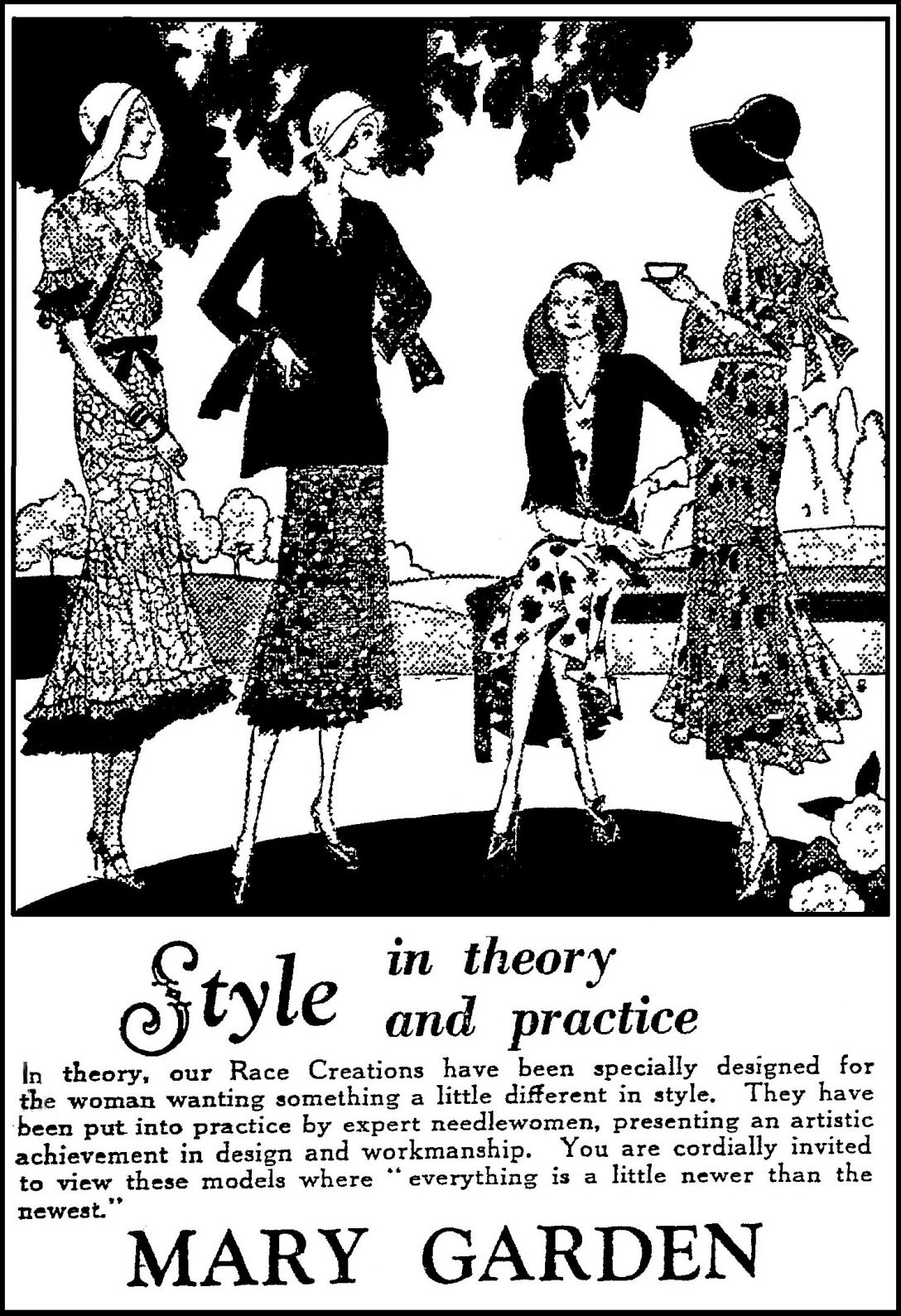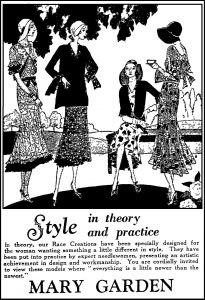In the 1920s, the societal norms shattered in the First World War combined with a booming economy and led to the emergence of a new generation of emancipated young women – the ‘flappers’.
They wore hemlines above the ankle, cut and ‘bobbed’ their hair, listened to jazz and generally rebelled against the path that society expected young women to follow. They smoked cigarettes, drank alcohol, took lovers rather than husbands, sought employment and flaunted their disdain for what was then considered acceptable behaviour. For more than a decade, one woman was looked up to by this new generation in Wellington, someone who ‘had it all’; a fashion designer, businesswoman and property developer who lived and worked under the pseudonym Mary Garden.
She was born in Hobart in Tasmania in January 1893 as Ruby Russell and likely grew up on a farm not far from that city. However, Ruby had bigger ambitions; training as a dressmaker, she went on to develop her craft at the luxurious ‘Farmers & Co’ department store in central Sydney (unconnected to the NZ retail chain of the same name).
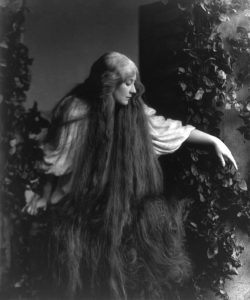
In 1924 she moved to Wellington and established her own dress-making business above 100 Manners Street. Shortly after arriving in New Zealand she reinvented herself and took on her pseudonym having lifted the name from the ‘real’ Mary Garden, a legendary Scottish-born opera singer and silent movie star, famous for her beauty, talent and wealth (by 1914 she was earning the 2021 inflation-adjusted equivalent of NZ $2.3 million per season at the New York Opera and could command the equivalent of $50,000 for a single performance).
‘Mary Garden Creations’ soon became Wellington’s best-known local fashion label producing “exclusive but inexpensive” clothes for New Zealand women and within a year over 40 staff were employed to turn Ruby’s designs into reality. Around the time her business was established she met Maurice Wilson, a dashing veteran of the First World War who had recently migrated to New Zealand from England and they soon fell in love. Though he was working for the Avery Scales Company as a travelling salesman, he was very familiar with the textile trade having grown up in Bradford in Yorkshire where his father owned a factory producing woollen yarn and his knowledge and contacts in the UK would have been very useful to Ruby’s business. However, complicating matters was the fact that Maurice was already married; in fact he had asked his wife Beatrice to join him in Wellington having already begun his relationship with Ruby. Within three weeks of her arrival in Wellington, Maurice left his wife and the divorce proceedings which followed were soon scandalous fodder for the pages of the NZ Truth newspaper. It took Beatrice another 18 months to earn enough money to pay for her return voyage to the UK.
In February 1926 Ruby and Maurice were married at the Presbyterian church which was once on the corner of Kent Terrace and Pirie Street, the bride wearing a fabulous dress and hat very likely of her own creation while her husband stuck to a traditional dark suit and top hat. The Evening Post described the wedding as being “quietly celebrated”; not entirely unexpected considering the groom had so recently divorced.


They moved into a flat on fashionable Oriental Parade and for the next four years Maurice worked in his wife’s business. Together they attended parties, the races and social gatherings befitting of their status. However, it was her name above the door and to some extent Maurice was a kept man with Ruby keeping her business at arm’s length from her husband. Though officially now Ruby Wilson, for the purposes of her business and the society-party circuit, she remained known to everyone as Mary Garden. Branches of Mary Garden Creations soon opened in Palmerston North and Hastings and the money poured in. Her next venture was to be property development; she acquired a sizable section in Mt Victoria which backed on to the Town Belt on which was sited an old run-down villa. It was demolished, the site was sub-divided and Ruby had two apartment blocks built at 105 and 107 Majoribanks Street, which survive to this day. She selected the prime apartment in 105 Majoribanks Street to be her own place of residence with all-day sun and views over the city. It became known as Courtlands on account of the private tennis court the apartments featured, the sport being Ruby’s favourite recreational pastime.
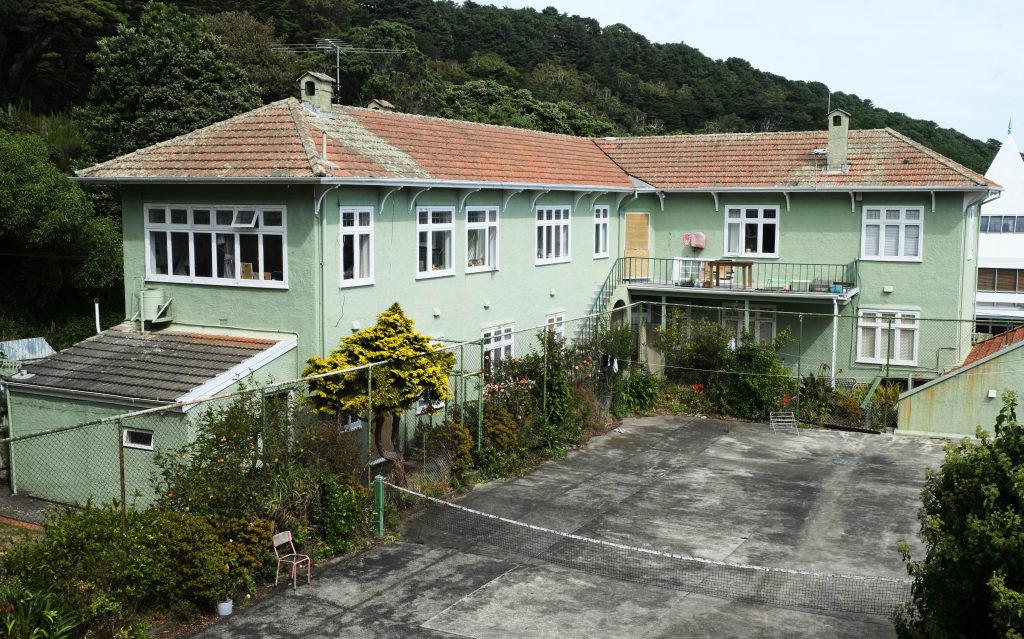
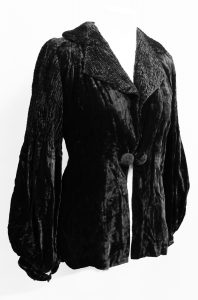
Despite the 1929 Wall Street Crash and the onset of the Great Depression, Mary Garden Creations remained profitable and advertising for the firm around this time often pointed out the number of ‘girls’ employed (over 100 by the early 1930s), something to be proud of when so many businesses were closing their doors and unemployment was reaching record levels. In August 1930, Ruby announced to the press that she was embarking on a combined business and pleasure trip to “the most important fashion centres of the world” including New York, London, Berlin and Paris. She travelled to Auckland and set off on the S.S. Aorangi on the first leg of her tour… without Maurice. An unsettled man with a taste of adventure who could have still been suffering from the horrors he witnessed on the Western Front, Maurice Wilson remained in their Majoribanks Street apartment – but not for long. Four months after Ruby’s departure, he boarded the same ship she had travelled on, now on its next circuit to the northern hemisphere and he made his way to Canada. However, he was not following his wife – he was leaving her and the two never saw each other again.
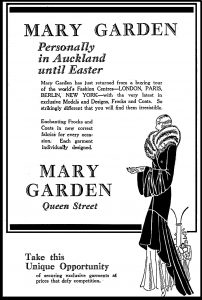 Ruby returned to New Zealand full of new and creative ideas of how her business could continue to grow despite the severe economic downturn of the Great Depression. In 1931 she sold a substantial share in her company (keeping a majority for herself), possibly to raise capital to inject into the new branch of Mary Garden which had opened at 140 Queen Street in Auckland and she was soon regularly travelling between the two cities. Meanwhile, Maurice Wilson bounced from Canada to the United States to South Africa before returning to the UK, leaving a trail of broken hearts behind him. Fuelled by stories of the multiple British attempts to climb Mt Everest in the 1920s, he obtained his pilot’s license and purchased a de Havilland Gypsy Moth biplane. His original plan was to fly from the UK to Nepal, crash-land on the slopes of Mt Everest, then (despite having no mountaineering experience) walk the rest of the way to become the first person to summit the world’s highest peak. In 1933 having been denied permission to enter Nepal, he landed in India, travelled overland to Tibet and secretly attempted to climb Everest with the help of three local porters. Unsurprisingly, with such limited experience, knowledge and supplies, he perished in his attempt. Newspapers throughout the world made much of the fact that he was last seen heading up the mountain from his base-camp carrying three loaves of bread and two tins of porridge.
Ruby returned to New Zealand full of new and creative ideas of how her business could continue to grow despite the severe economic downturn of the Great Depression. In 1931 she sold a substantial share in her company (keeping a majority for herself), possibly to raise capital to inject into the new branch of Mary Garden which had opened at 140 Queen Street in Auckland and she was soon regularly travelling between the two cities. Meanwhile, Maurice Wilson bounced from Canada to the United States to South Africa before returning to the UK, leaving a trail of broken hearts behind him. Fuelled by stories of the multiple British attempts to climb Mt Everest in the 1920s, he obtained his pilot’s license and purchased a de Havilland Gypsy Moth biplane. His original plan was to fly from the UK to Nepal, crash-land on the slopes of Mt Everest, then (despite having no mountaineering experience) walk the rest of the way to become the first person to summit the world’s highest peak. In 1933 having been denied permission to enter Nepal, he landed in India, travelled overland to Tibet and secretly attempted to climb Everest with the help of three local porters. Unsurprisingly, with such limited experience, knowledge and supplies, he perished in his attempt. Newspapers throughout the world made much of the fact that he was last seen heading up the mountain from his base-camp carrying three loaves of bread and two tins of porridge.
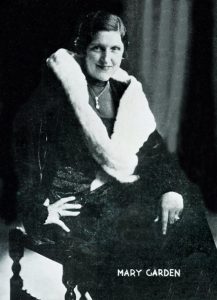
The death of her husband was confirmed when his body was recovered in 1935. This conveniently gave Ruby ‘widow’ status; something which was far more preferable in that era to ‘divorcee’. However, before Maurice Wilson’s death it is likely that she was already in another relationship. The Hastings branch of Mary Garden was located in a new Spanish-Mission style retail building in the centre of town called Villa d’Este. It was owned and had been developed in 1929 by J. R (James Robert) Kirk, a prominent lawyer and businessman who was originally from Dunedin but who had lived in several centres around NZ before eventually settling in Wellington.
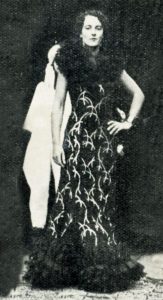
He had served as a director on the boards of several significant companies, was elected mayor of both Naseby and Gisborne, was a J.P., held senior positions on several education boards and commissions, was active in the senior administration of the NZ Scouting movement and the NZ Native Bird Protection Society (now ‘Forest and Bird’) and had been awarded an M.B.E. With such a background, it was perhaps not entirely unsurprising that he should be attracted to his glamorous, high-achieving, independently wealthy tenant and the two began an affair. The complicating matter was that (once again) James Kirk was married and the eldest of his four adult children was only about 10 years younger than Ruby. Around this time Mary Garden Creations left their Manners Street premises and she opened a new boutique showroom and workshop at 260a Lambton Quay. Within a couple of years the retail outlet moved across the road to the much more fashionable ‘Harcourt Chambers’ which were once located on the corner of Lambton Quay and Panama Street.
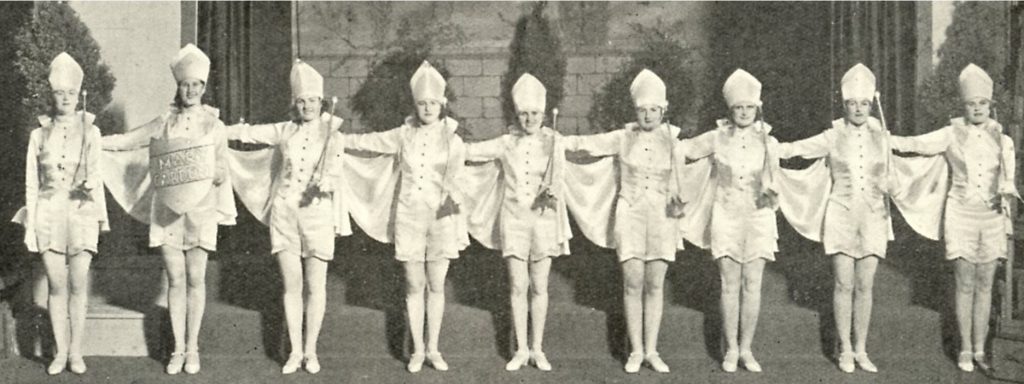
By 1936 James Kirk had left his wife of 30 years and had moved into Courtlands with Ruby. The scandal was the talk of the town and it split his family; only his second son Horace (later to establish Kirk Motors in Auckland) was said to have maintained contact with his father. The nature of the affair while he was still married may have been why Kirk suddenly resigned his position as Chairman of the NZ Scout Association, a post he had held for a decade. During a visit to Wellington as a young boy, one of his grandchildren recalls being driven up to the top of Majoribanks Street and being told by his aunt “this is where your grandfather lives” but no doors were knocked on and the two never met.

 However, within a couple of years, Ruby had had enough of being a businesswoman. She had considerable assets and had worked hard for many years; it was time to take things a little easier. It’s also possible that she may have struggled to adapt to the new fashion trends of the late 1930s and she began to wind up her firm. When her lease in the Harcourt Chambers came to an end, she sold off her equipment and remaining stock and in late June 1938 Mary Garden Creations was removed from the Companies Register. Her staff were ‘let go’ but many went into business as dressmakers themselves, proudly stating how they had formerly been an employee of Mary Garden, such was her reputation. She then took a senior position within the dress department of the D.I.C. (department store) on Lambton Quay just across the road from where her business had been located.
However, within a couple of years, Ruby had had enough of being a businesswoman. She had considerable assets and had worked hard for many years; it was time to take things a little easier. It’s also possible that she may have struggled to adapt to the new fashion trends of the late 1930s and she began to wind up her firm. When her lease in the Harcourt Chambers came to an end, she sold off her equipment and remaining stock and in late June 1938 Mary Garden Creations was removed from the Companies Register. Her staff were ‘let go’ but many went into business as dressmakers themselves, proudly stating how they had formerly been an employee of Mary Garden, such was her reputation. She then took a senior position within the dress department of the D.I.C. (department store) on Lambton Quay just across the road from where her business had been located.
James Kirk entered into divorce proceedings with his wife and shortly after it was granted, he married Ruby at St. Andrew’s Presbyterian Church in Hastings in March 1941. With the war on, the papers reported that “in keeping with the sentiment of the times, the wedding was a quiet one, only close friends being present, but nevertheless it created much interest…”. After their honeymoon, they could at last be open about their relationship and they threw a party at Courtlands which was attended by the upper echelon of Wellington society. For a brief period, the two lived happily as husband and wife, enjoying their tennis court and engaging in various ‘patriotic causes’ to help with the war effort. However, it was not to last. On the evening of Wednesday 1st September 1943, James Kirk died suddenly from a heart attack in their Majoribanks St apartment at the age of 65. After a second marriage lasting just over two years, Ruby was once again a widow. She moved to Auckland where she lived on the North Shore for a brief period in the mid-late 1940s, receiving regular income from the rent received from Villa d’Este as stipulated in James Kirk’s will and likely sold Courtlands at around this time. She then left NZ in 1952 to travel to the UK before returning to Australia. She purchased a unit in the famous Glenhurst Gardens modernist apartment complex at Darling Point in Sydney around the time the building was being constructed and was still living there when she died on 5th May 1962, aged 69.
 The story of Maurice Wilson’s adventures has now been published by the award-winning British journalist and writer Ed Caesar. His book The Moth and the Mountain: a True Story of Love, War and Everest is now in the collection of Wellington City Libraries as both an e-book and in hardcopy.
The story of Maurice Wilson’s adventures has now been published by the award-winning British journalist and writer Ed Caesar. His book The Moth and the Mountain: a True Story of Love, War and Everest is now in the collection of Wellington City Libraries as both an e-book and in hardcopy.


